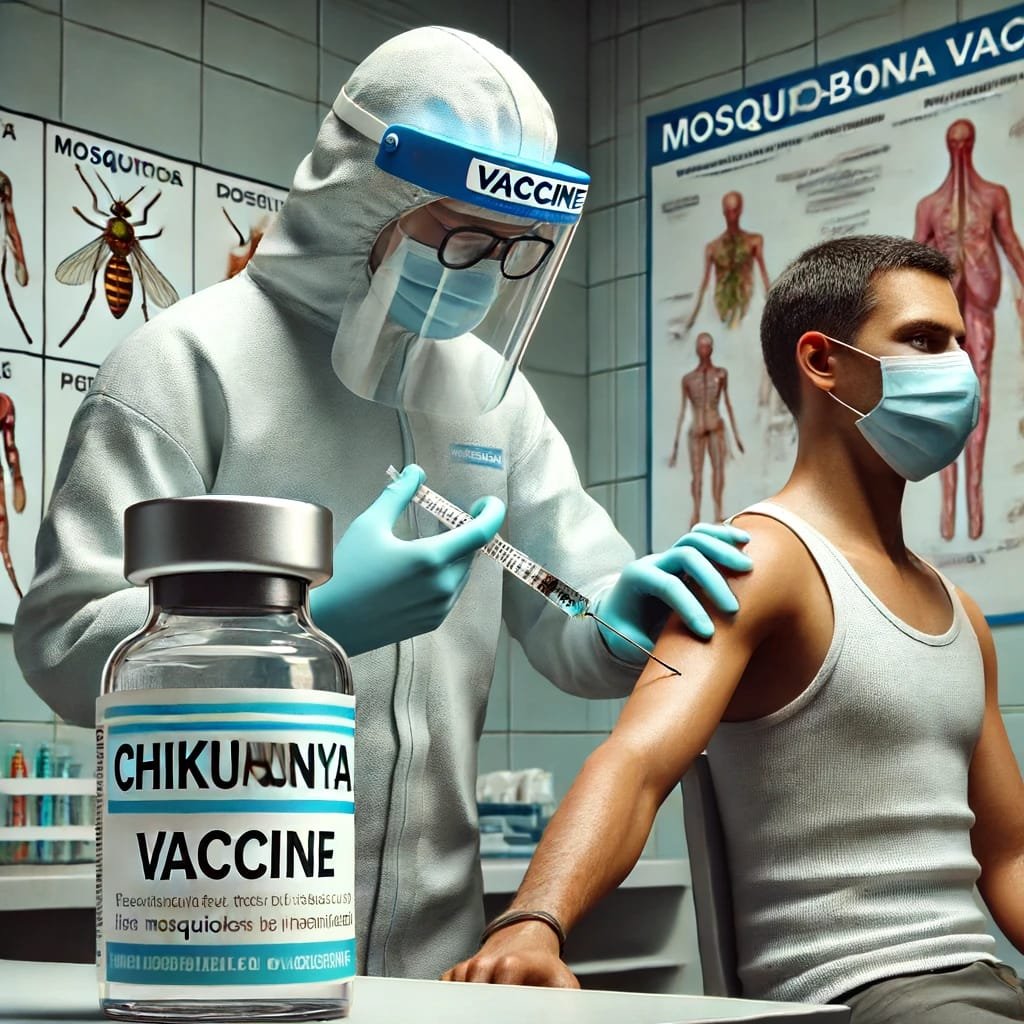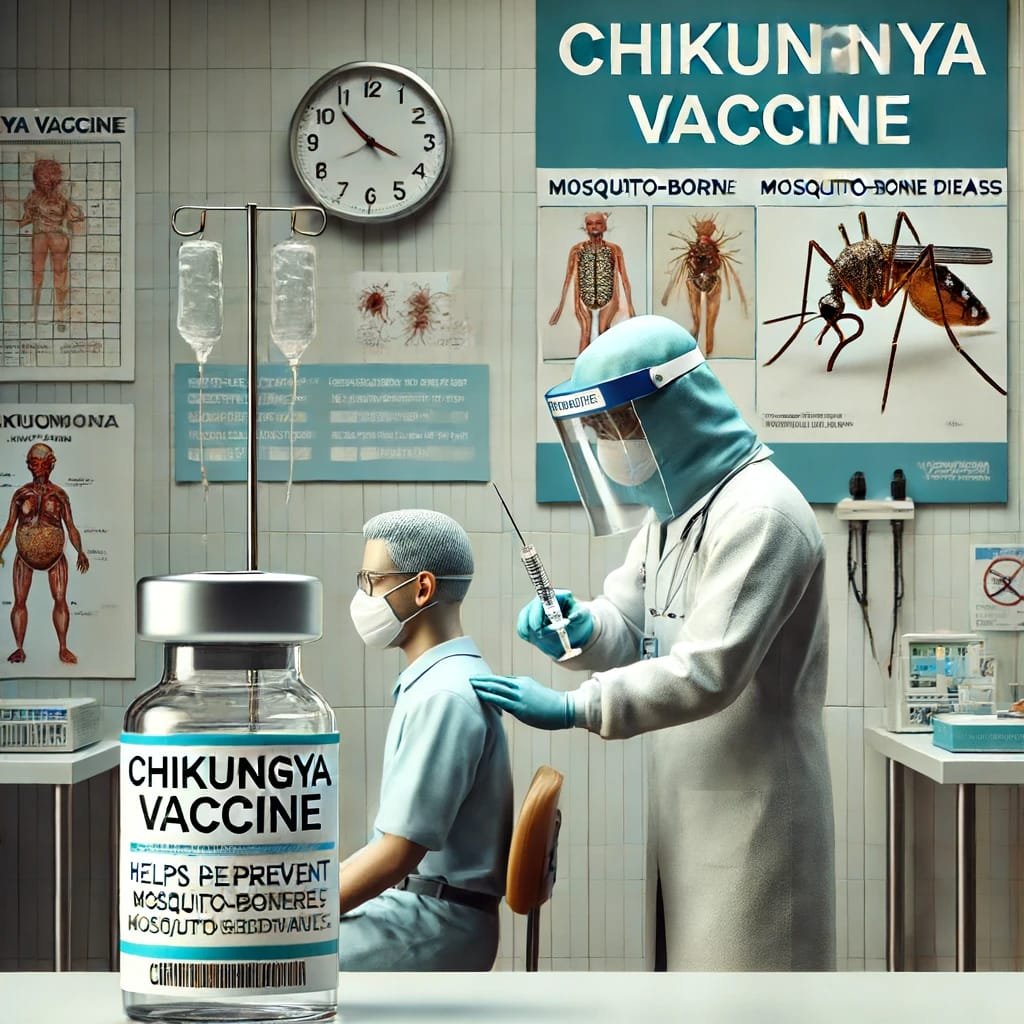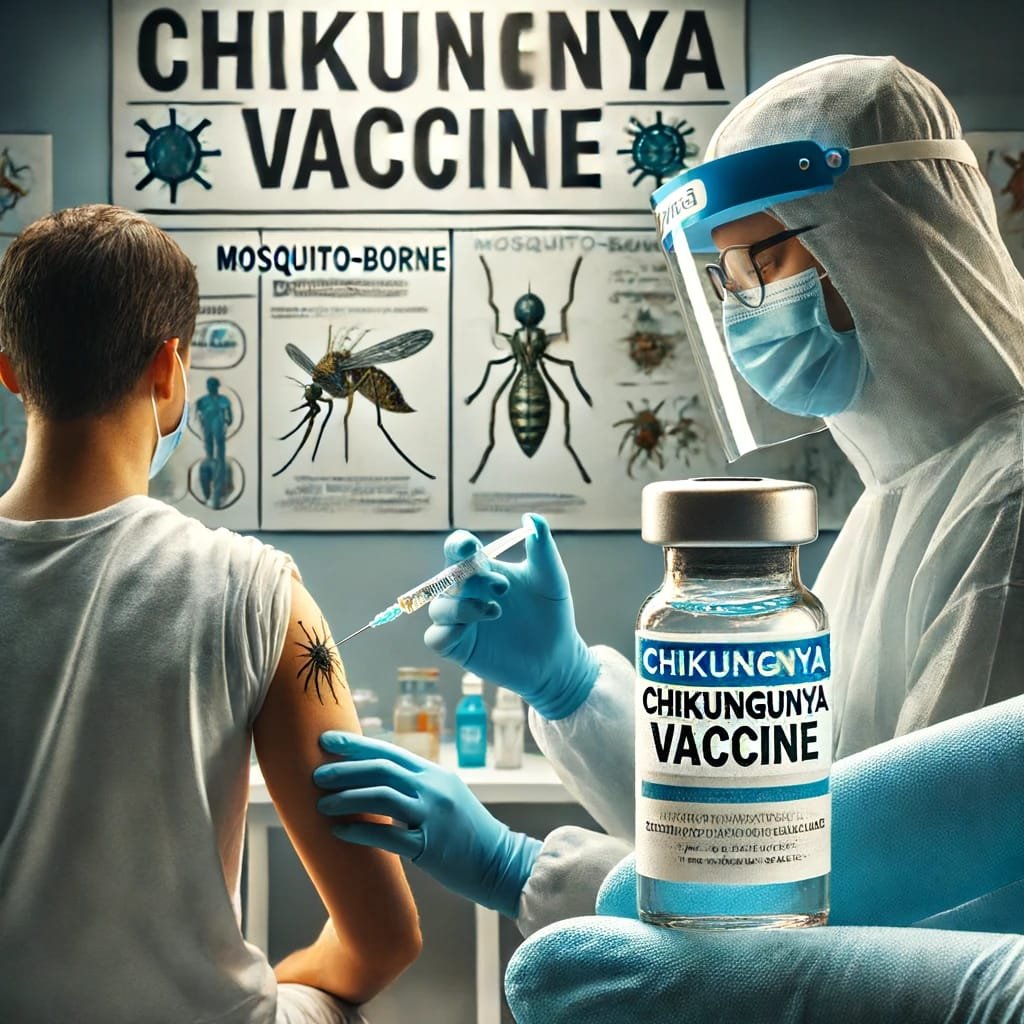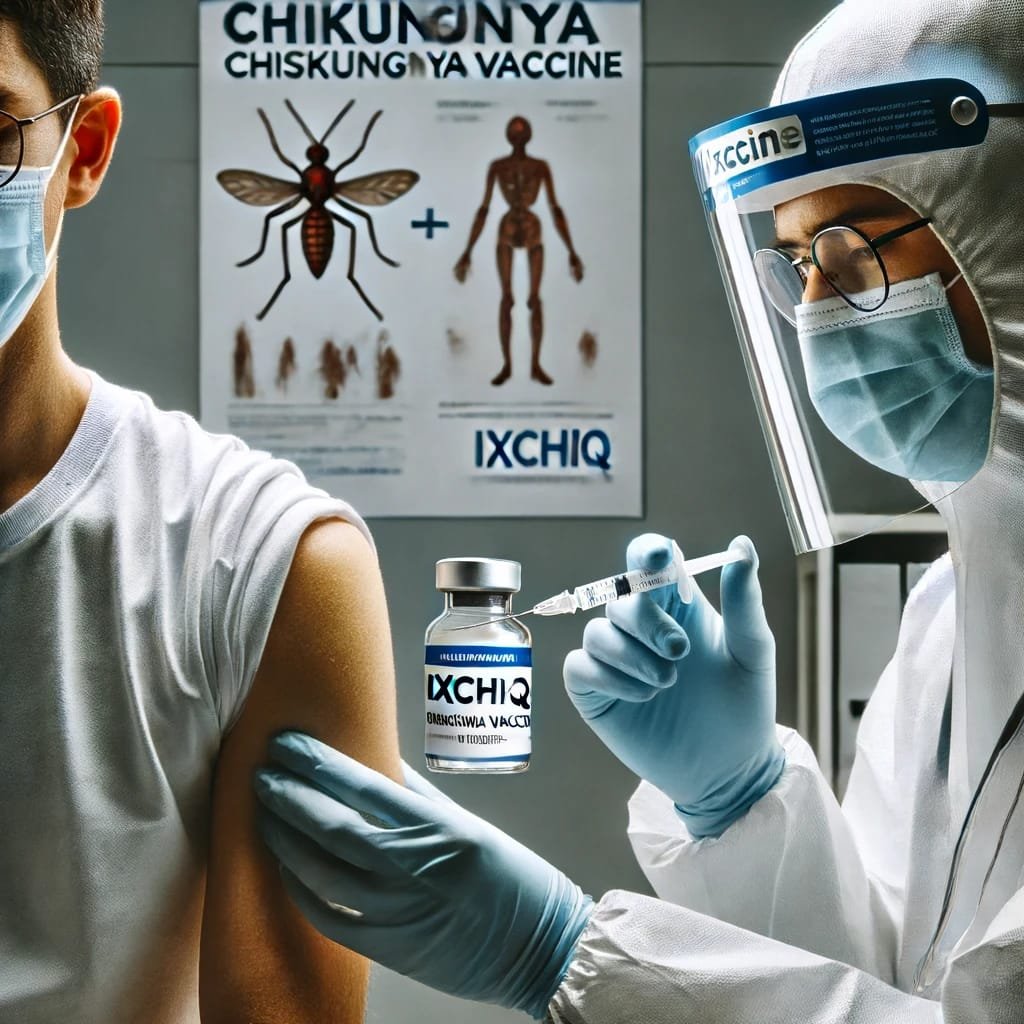Table of Contents
ToggleIntroduction to Chikungunya Vaccine
What is Chikungunya Vaccine?
Chikungunya Vaccine is a viral disease transmitted to humans by infected mosquitoes, primarily the Aedes aegypti and Aedes albopictus species. The name “Chikungunya” is derived from the Makonde word meaning “that which bends up,” referencing the contorted posture of sufferers due to severe joint pain. The disease manifests abruptly with fever and joint pain, often debilitating enough to impede daily activities. While not typically fatal, the symptoms can be intense and lingering, significantly affecting the quality of life.

History and Spread
The Chikungunya virus was first identified during an outbreak in southern Tanzania in 1952. Since its discovery, the virus has caused numerous outbreaks across Africa and Asia, with a marked increase in frequency and geographic range over the past two decades. The virus’s spread to the Americas and Europe is attributed to increased international travel and the adaptability of the virus to new mosquito vectors. Significant outbreaks in India, Southeast Asia, and the Caribbean have underscored the virus’s potential for widespread transmission, making it a global health concern.
Symptoms and Diagnosis
Chikungunya Vaccine presents with an abrupt onset of fever, often accompanied by severe joint pain, which distinguishes it from other viral illnesses. Additional symptoms include muscle pain, headache, nausea, fatigue, and rash. The joint pain can be so severe that it leads to a stooped posture, sometimes causing the disease to be misdiagnosed as rheumatoid arthritis. Diagnosis is primarily clinical, supported by laboratory tests such as reverse transcription-polymerase chain reaction (RT-PCR) to detect viral RNA and serological tests to identify antibodies against the virus. Early and accurate diagnosis is crucial for managing symptoms and preventing misdiagnosis.
Understanding the Need for a Chikungunya Vaccine
The Impact of Chikungunya Vaccine on Global Health
Chikungunya’s impact on global health is significant, with millions of cases reported worldwide. The disease is particularly prevalent in tropical and subtropical regions, where the mosquito vectors thrive. During outbreaks, the virus can infect a large portion of the population, leading to widespread illness. The severe joint pain and fatigue associated with Chikungunya Vaccine can incapacitate individuals, reducing their ability to work and perform daily activities. This, in turn, places a heavy burden on healthcare systems, which must manage both acute cases and the long-term complications that some patients experience.
Economic and Social Implications
The economic and social implications of Chikungunya Vaccine are profound. Outbreaks can disrupt local economies, especially in regions dependent on agriculture and tourism. The disease’s debilitating symptoms lead to significant productivity losses as infected individuals are often unable to work for extended periods. Healthcare costs escalate due to the need for prolonged medical care and the treatment of chronic symptoms. Additionally, the fear of contracting the virus can deter tourists and investors, further impacting economic stability. Socially, communities affected by Chikungunya Vaccine often face challenges in maintaining daily routines and supporting those with long-term disabilities caused by the virus.
Current Treatment Options
There isn’t a specific antiviral medication available for Chikungunya right now. Management of the disease focuses on relieving symptoms through supportive care. This includes the use of pain relievers such as acetaminophen or ibuprofen to reduce fever and alleviate joint pain. Severe cases may require hospitalization for more intensive care, including intravenous fluids and medications to manage pain and inflammation. Patients are also advised to rest and increase fluid intake. While these measures can help mitigate symptoms, they do not address the root cause of the infection, highlighting the need for a preventative Chikungunya vaccine to reduce the incidence and severity of Chikungunya Vaccine outbreaks.
Development of the Chikungunya Vaccine
Early Research and Discoveries
Early research into a Chikungunya vaccine began shortly after the virus was first identified. Scientists recognized the need for a Chikungunya vaccine due to the virus’s potential for widespread outbreaks and the severe impact on those infected. Initial studies focused on understanding the virus’s structure and how it interacts with the human immune system. These foundational discoveries paved the way for the development of Chikungunya vaccine candidates. Researchers experimented with various approaches, including inactivated virus vaccines, live attenuated vaccines, and subunit vaccines, to determine the most effective strategy for inducing immunity against Chikungunya.

Key Players in Chikungunya Vaccine Development
Several key players have been instrumental in the development of the Chikungunya vaccine. Both governmental and non-governmental organizations have played vital roles in funding and conducting research. The National Institutes of Health (NIH) in the United States, along with pharmaceutical companies such as Bharat Biotech and Valneva, have been at the forefront of vaccine development. Collaborative efforts between these entities have accelerated the progress of clinical trials and regulatory approvals. Additionally, international organizations like the World Health Organization (WHO) have provided crucial support in coordinating global efforts to combat Chikungunya Vaccine through vaccination.
Clinical Trials and Their Phases
The development of the Chikungunya vaccine has involved rigorous clinical trials to ensure safety and efficacy. These trials are conducted in phases, each designed to answer specific research questions. Phase I trials primarily focus on safety, evaluating the vaccine in a small group of healthy volunteers to assess any adverse effects and determine the appropriate dosage. Phase II trials expand the study to a larger group to further evaluate safety and begin to assess the Chikungunya vaccine’s efficacy in generating an immune response. Phase III trials involve thousands of participants and aim to confirm the vaccine’s effectiveness in preventing Chikungunya Vaccine infection in diverse populations. Successful completion of these phases is required before a vaccine can be approved for widespread use.
How the Chikungunya Vaccine Works
Mechanism of Action
The Chikungunya vaccine works by stimulating the body’s immune system to recognize and fight the Chikungunya Vaccine virus. It typically involves using an inactivated or attenuated form of the virus, viral proteins, or genetic material that mimics the virus. When introduced into the body, the immune system responds by producing antibodies. These antibodies are specific to the Chikungunya Vaccine virus and can neutralize the virus if the vaccinated person is later exposed to it. This immune response is crucial for preventing the onset of the disease and reducing its severity.
Types of Chikungunya Vaccines Developed
Several types of Chikungunya vaccines have been developed, each with different approaches. Inactivated vaccines use a virus that has been killed and cannot replicate, which is safe but may require multiple doses to be effective. Live attenuated vaccines use a weakened form of the virus that can still replicate but is not strong enough to cause disease in healthy individuals. These Chikungunya vaccines often provide long-lasting immunity with fewer doses. Additionally, recombinant vaccines use viral proteins produced in the laboratory to stimulate an immune response. DNA and mRNA vaccines, which use genetic material to instruct cells to produce viral proteins, represent newer technologies being explored for Chikungunya vaccination. Each type has its advantages and challenges, influencing their development and use.
Efficacy and Safety Data
The efficacy and safety of Chikungunya vaccines have been demonstrated through extensive clinical trials. These trials typically involve several phases, starting with small groups of volunteers to assess safety, followed by larger groups to evaluate efficacy and optimal dosing. Results from these trials have shown that the Chikungunya vaccines can significantly reduce the incidence and severity of Chikungunya Vaccine infection. For instance, some vaccines have shown efficacy rates of over 90% in preventing symptomatic Chikungunya Vaccine infection. Safety data have also been reassuring, with most vaccines causing only mild side effects, such as injection site pain, fever, and fatigue, which are common with many vaccines. Serious adverse effects are rare, underscoring the favorable risk-benefit profile of these vaccines.
Availability and Accessibility
Approved Chikungunya Vaccines and Their Availability
As of now, several Chikungunya vaccines have been approved for use in different parts of the world. These include both live attenuated and inactivated vaccines, each suited to different populations and epidemiological contexts. For example, the European Medicines Agency (EMA) has approved certain vaccines for use in Europe, while regulatory authorities in India and Southeast Asia approve other vaccines. Availability can vary based on the region, with some vaccines being distributed primarily in countries with high endemicity of Chikungunya.

Distribution Challenges
Despite developing and approving effective Chikungunya vaccines, distributing them to those in need presents significant challenges. Logistics of cold chain storage, especially in tropical and subtropical regions where Vaccine is most prevalent, can be difficult. Additionally, infrastructure limitations, such as inadequate transportation networks and healthcare facilities, hinder widespread distribution. Political instability and lack of public health funding in some regions further complicate vaccine rollout. Ensuring equitable vaccine access remains a critical issue, requiring coordinated efforts between governments, international organizations, and private stakeholders.
Cost and Funding Initiatives
The cost of vaccines and funding initiatives play a vital role in their accessibility. Chikungunya Vaccine development is expensive, and these costs often translate into high prices for end-users, particularly in low- and middle-income countries. However, various funding initiatives and partnerships aim to mitigate these costs. Organizations like Gavi, the Vaccine Alliance, and the World Health Organization (WHO) work to subsidize vaccine prices and support distribution in under-resourced areas. Public-private partnerships also contribute to funding research and development, making vaccines more affordable and accessible. Additionally, national governments and international donors often provide funding to purchase and distribute vaccines, ensuring broader coverage and protection against Chikungunya.
Global Vaccination Efforts
Vaccination Campaigns and Strategies
Vaccination campaigns for Chikungunya Vaccine are critical in mitigating the spread of the disease, particularly in regions prone to outbreaks. These campaigns typically involve extensive planning and coordination to ensure the Chikungunya vaccine reaches the target population effectively. Strategies include mass immunization drives in endemic areas, prioritizing high-risk groups such as healthcare workers, and integrating the Chikungunya vaccine into routine immunization schedules. Public health officials also focus on community engagement and education to inform the public about the benefits of vaccination, addressing any misconceptions and encouraging participation.
Role of Governments and International Organizations
Governments play a pivotal role in the successful implementation of vaccination programs. National health departments are responsible for procuring vaccines, developing distribution plans, and ensuring that healthcare infrastructure is equipped to handle the immunization process. International organizations such as the World Health Organization (WHO), the Centers for Disease Control and Prevention (CDC), and various non-governmental organizations (NGOs) provide essential support. This covers resources such as money, technological support, and logistics and cold chain management know-how. Collaborative efforts between countries and global health entities are crucial for managing cross-border outbreaks and ensuring equitable access to vaccines.
Success Stories and Case Studies
Several regions have demonstrated successful implementation of Chikungunya vaccination campaigns, providing valuable case studies for other areas facing similar challenges. For instance, in the Indian Ocean region, coordinated efforts by local governments and international partners led to a significant reduction in Chikungunya Vaccine cases through targeted vaccination and vector control measures. Another example is the Caribbean, where community-based approaches and effective use of public health messaging significantly improved vaccine uptake. These success stories highlight the importance of tailored strategies that consider local contexts and involve community participation to achieve high vaccination coverage and control the spread of Chikungunya.
Challenges and Future Directions
Addressing Vaccine Hesitancy
Vaccine hesitancy remains a significant barrier to achieving high vaccination coverage. Misinformation, cultural beliefs, and mistrust of health authorities contribute to reluctance to accept vaccines. Addressing these concerns requires a multifaceted approach, including transparent communication about the vaccine’s safety and efficacy, engaging with community leaders to build trust, and leveraging social media platforms to counteract misinformation. Educational campaigns that provide accurate information and highlight the personal and community benefits of vaccination can also help mitigate hesitancy.
Improving Chikungunya Vaccine Coverage
To improve Chikungunya vaccine coverage, it is essential to enhance accessibility and affordability. This involves ensuring that vaccines are available in remote and underserved areas through mobile clinics and outreach programs. Subsidizing the cost of vaccines and providing them for free in low-income regions can also increase uptake. Strengthening healthcare systems to manage the logistics of large-scale vaccination campaigns is crucial. Additionally, continuous monitoring and evaluation of vaccination programs help identify gaps and areas for improvement, enabling health authorities to adjust strategies and ensure more comprehensive coverage.

Future Research Directions
Future research on Chikungunya vaccines focuses on developing more effective and long-lasting vaccines, as well as exploring different vaccine delivery methods. Innovations such as needle-free injectors and thermostable vaccines that do not require cold storage can significantly enhance vaccination efforts in resource-limited settings. Research is also ongoing to understand the long-term immunity provided by current vaccines and to develop second-generation vaccines that may offer broader protection against different strains of the virus. Collaboration between scientists, public health experts, and policymakers is essential to advance these research initiatives and translate findings into practical solutions for controlling Chikungunya.
Conclusion
The development and implementation of a Chikungunya vaccine represent significant milestones in the global effort to combat this debilitating disease. Chikungunya, known for its severe joint pain and long-lasting symptoms, has posed considerable public health challenges, especially in tropical and subtropical regions. The introduction of an effective vaccine offers hope for reducing the burden of this disease and preventing future outbreaks.Understanding the need for a vaccine is crucial, given the substantial health, economic, and social impacts of Chikungunya. While current treatments focus on symptom management, the vaccine provides a proactive solution to prevent the disease altogether. The journey of developing the Chikungunya vaccine has involved extensive research, numerous clinical trials, and the collaboration of key players in the scientific community.
Frequently Asked Questions (FAQs)
What is the current status of the Chikungunya vaccine?
The current status of the Chikungunya vaccine involves multiple candidates undergoing clinical trials, with some achieving regulatory approval in certain regions. These vaccines have shown promising results in terms of safety and efficacy, providing protection against the Chikungunya Vaccine virus. Ongoing research and development efforts aim to improve these vaccines and expand their availability globally.
Are there any side effects of the Chikungunya vaccine?
Like all vaccines, the Chikungunya vaccine may cause side effects, though they are generally mild and temporary. Common side effects include pain at the injection site, mild fever, headache, and fatigue. Serious side effects are rare. Clinical trials and post-marketing surveillance continue to monitor the safety profile of these vaccines to ensure they remain safe for public use.
Who should get the Chikungunya vaccine?
The Chikungunya vaccine is recommended for individuals living in or traveling to areas with high transmission rates of the virus. High-risk groups, including healthcare workers, people with underlying health conditions, and those residing in outbreak-prone regions, are particularly encouraged to get vaccinated. Public health guidelines may vary, so it is advisable to consult with healthcare providers or local health authorities for specific recommendations.

